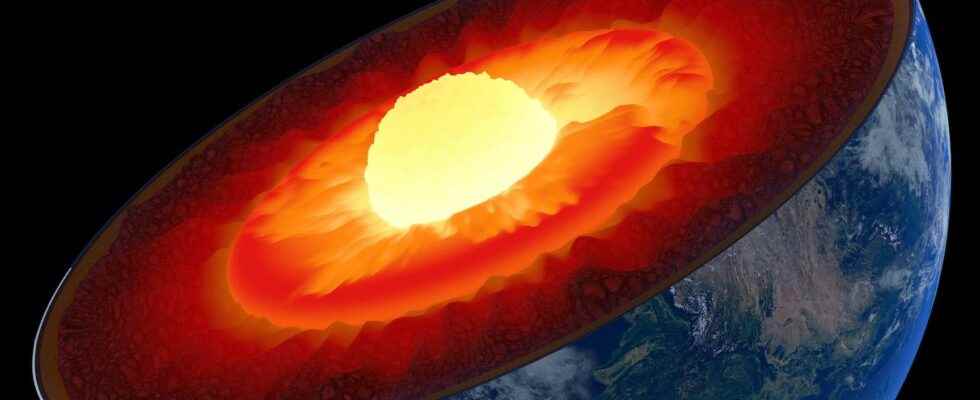You will also be interested
[EN VIDÉO] The core of the Earth reconstructed in the laboratory By spinning liquid sodium around a 23-tonne sphere, geophysicists at the University of Maryland simulate the conditions around our planet’s core. Goal of the game: to understand why the Earth is the only telluric planet in the Solar System to possess a strong magnetic field which protects us from the wrath of the Sun. Here is this amazing experience in video.
I’helium is one of chemical elements composing the terrestrial rocks and a part is inherited from the time when our Planet began its formation. Helium, like other volatile elements, was indeed present in the nebula at the origin of our Sun and other planets Solar system. The study of these elements within terrestrial rocks, and in particular their quantity, thus makes it possible to go back to the composition of the primitive nebula and to retrace the history of the formation of the Earth.
A primordial gas stored in the depths of the Earth
Chemical analyzes of rocks show that these volatile elements are present in the very inner parts of the Earth: the coat and potentially, the core. If our knowledge of the composition of the primitive mantle begins to be quite precise, the composition of the Earth’s core still remains very approximate, because of the impossibility of having access to these very deep regions of the globe.
However, we know by direct observation that helium-3 (3He) escapes continuously from the interior of the Earth at the level of the ridges, during the process of creation of the oceanic crust. However, unlike the very common helium-4 (4He) which is found in abundance on Earth — and which is one of the products of the decay of radioactive elements uranium and thorium –, helium-3 is a gas very rare primordial, created shortly after the Big Bang. It was thus part of the nebula that gave birth to the Sun and the Earth.
Despite the different stages in the formation of the Earth which have largely contributed to the degassing essential volatile elements, especially during the intense meteorite bombardment, the formation of the Moon or the solidification of the magma ocean, it appears that the Earth has managed to keep a reservoir of helium-3 hidden in its deep layers. But where exactly is it located and what is the amount of 3He remaining?
The outer core, a helium-3 reservoir?
The presence of helium-3 in the basalts products at the ocean ridgesbut also hot spotsindicates that this reservoir is located at depth and that this chemical element is certainly transported to the surface via the process of mantle convection. Light gas par excellence, once released on the surface, helium-3 is recycled very little: only a tiny quantity will return to the depths of the mantle through subduction zones. Almost all of this gas is indeed released in theatmosphere, then into space. Acquired 4.56 billion years ago, the deep reservoir of helium-3 is therefore not replenished.
In a recent study, scientists were interested in the characterization of this reservoir. Their basic hypothesis is that the Earth’s core could represent a good storage area for this primordial gas. Located at a depth of more than 2,800 km, the core is, in fact, the deepest region of the Earth and therefore represents the most protected zone from meteorite impacts involved in the degassing of the primitive mantle.
Moreover, the rocks of the core do not participate directly in the cycles of the tectonic plates that affect the superficial layers. The state of the outer core has also changed very little since its formation and has remained mostly in form liquid. The outer core could therefore represent a favorable location for the storage of noble gases such ashydrogen or helium. However, how these elements could be integrated into it in a stable way is still far from being understood.
A continuous leak of helium
To constrain the location of this helium-3 reservoir within the outer core, two scientists from the University of New Mexico in Alburquerque (United States) carried out calculations to quantify helium-3 outgassing and understand the exchanges between the core and the mantle during the history of the Earth.
The results, published in Geochemistry, Geophysics, Geosystems, show that the dissolution of the primitive atmosphere resulting from the nebula would have allowed the integration of one or several million tons of 3He in the nucleus in formation, 4.5 billion years ago. Based on core-mantle interaction and outgassing models via the process of convectionthe researchers estimate that the amount of 3He in the mantle is currently evolving towards a steady state, in which surface leakage is compensated by continued enrichment from the core where most of the remaining helium-3 is stored.
Support your independent scientific media: discover our subscription formulas!
4 good reasons to subscribe to Futura on Patreon:
- A site without any advertising from 3.29 euro per month.
- It is without commitment.
- Access to priority content, in preview, just for you.
- You support our business in the best possible way. A real motivation for us!
Interested in what you just read?
